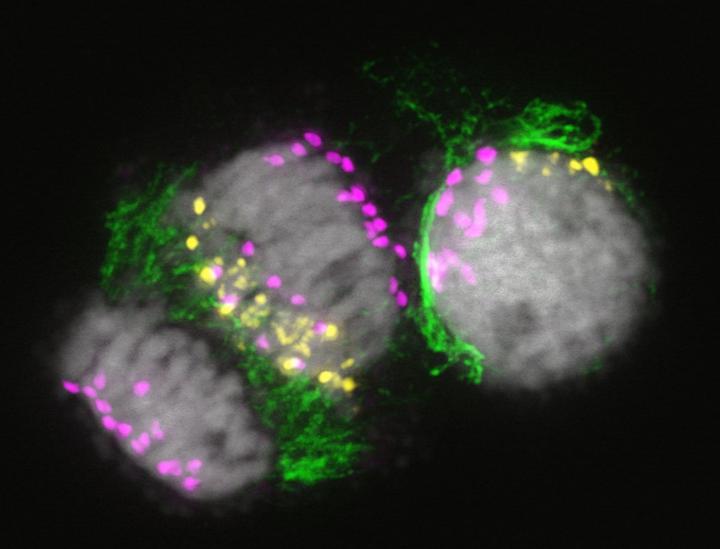Process behind the organ-specific elimination of chromosomes in plants unveiled

Supernumerary B chromosomes of Ae. speltoides undergoing process elimination. B chromosomes were labelled in yellow, centromeres in purple and tubulin in green. Credit: Dr. Alevtina Ruban/ IPK
Some plants and animals on the other hand, are known to systematically ensure that the DNA content between some of their organs differs. Whilst the phenomenon of “programmed DNA elimination” has been known since 1887, the process with which plants achieve it, had stayed elusive.
Researchers from the Leibniz Institute of Plant Genetics and Crop Plant Research (IPK) in Gatersleben have now finally been able to explain the underlying mechanisms.
Within their investigation, the researchers focused on the organ-specific elimination of B chromosomes within goatgrass, Aegilops speltoides. B chromosomes are “selfish” chromosomes, which bring no apparent benefit to the organism. Goatgrass, a progenitor of our common wheat, can carry up to 8 of these supernumerary chromosomes. However, whilst B chromosomes can be found in the leaves, stem and flower of the grass, their roots are a B chromosome-free zone.
Through the detailed investigation and comparison of Ae. speltoides strains with and without B chromosomes, the researchers gained novel insights into the origins of B chromosomes. Further, their observations confirmed that the elimination of selfish chromosomes is a strictly controlled root-specific process.
The elimination starts with the onset of the embryonic tissue differentiation and can eradicate up to 100% of the targeted B chromosomes. As Prof. Andreas Houben let us know: “Elimination of B chromosomes occurs due to mitotic chromosome nondisjunction.
This means that the cellular transport of the B chromosomes is impaired, and as a consequence, the B chromosomes are separated from the standard chromosomes. Then, in the final step of the elimination, the DNA of B chromosomes is degraded.”
With its exceptional efficiency rate, the programmed elimination process of chromosomes has the potential of becoming a highly useful addition to the genetic toolbox. When induced artificially, it could enable the elimination of chromosomes or chromosome sets for medical or plant breeding purposes.
In the meanwhile, plants continue to benefit from their process in a more down to earth way – the research suggests that the removal of the supernumerary chromosomes spares the root cells from having potentially harmful B chromosome located genes.
Media Contact
More Information:
http://dx.doi.org/10.1038/s41467-020-16594-xAll latest news from the category: Life Sciences and Chemistry
Articles and reports from the Life Sciences and chemistry area deal with applied and basic research into modern biology, chemistry and human medicine.
Valuable information can be found on a range of life sciences fields including bacteriology, biochemistry, bionics, bioinformatics, biophysics, biotechnology, genetics, geobotany, human biology, marine biology, microbiology, molecular biology, cellular biology, zoology, bioinorganic chemistry, microchemistry and environmental chemistry.
Newest articles

“Nanostitches” enable lighter and tougher composite materials
In research that may lead to next-generation airplanes and spacecraft, MIT engineers used carbon nanotubes to prevent cracking in multilayered composites. To save on fuel and reduce aircraft emissions, engineers…

Trash to treasure
Researchers turn metal waste into catalyst for hydrogen. Scientists have found a way to transform metal waste into a highly efficient catalyst to make hydrogen from water, a discovery that…

Real-time detection of infectious disease viruses
… by searching for molecular fingerprinting. A research team consisting of Professor Kyoung-Duck Park and Taeyoung Moon and Huitae Joo, PhD candidates, from the Department of Physics at Pohang University…





















